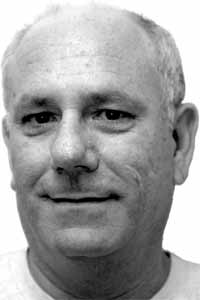Legacies lie where we least expect them

Dr. John Knapp, Professor of Geophysics
The moonrise was especially vibrant the other night. Maybe, I was overly receptive because I saw the huge, amber orb looming over the Frisco Building right after a few Boulevard ales at Decker’s Dog Bar with some Missouri Southern alumni and fellow Kappa Alpha brothers, but I don’t think so. Over the past year, I’ve been quite contemplative. Maybe it’s because I’ve completed my 15th year at Southern and the 25th year of my professional career? Possibly I’m starting to notice things like just how big the moon appears when hanging above the horizon? How many nights have I been oblivious of the moon? What if there was no moon? The moon isn’t just a rock in space, it’s romantic , it has a legacy, it’s lore. Yes. Legacy, that’s what I’ve been thinking about.A few weeks ago, I watched a full moon rise in Virginia; it’s more romantic there than in Missouri. The brochure at the rest stop informed me, “Virginia is for lovers.” Why then did they name it for virgins?At Washington and Lee University, I stood in the doorway of Robert E. Lee’s eerily quiet college office undisturbed from how he left it shortly before his death in 1870. Lee, said, “nothing is more instructive than the perusal of deeds of men in other ages.” He’s talking about legacy. When I’m gone, how long will my office remain untouched? Arlington National Cemetery resides on Lee’s former plantation, inherited when he married George Washington’s great granddaughter. It was confiscated and converted into a burial ground for Union soldiers, the Army’s revenge for Lee’s betrayal of his former fellow soldiers. Looking from Arlington House, atop the hill, thousands of perfectly aligned rows of white headstones fill the landscape in front of the White House and Capitol dome shimmering in the distance, across the Potomac River. What a gut-wrenching reminder of the price of the freedoms those buildings represent. Row after row after row of graves, the sound of Taps as the fancy-dressed honor guard meticulously places another wreath at the tomb of the Unknown Soldier; how many of our leaders have failed to journey to this site before voting war.America is fond of honoring it was dead. We appreciate their legacy, but how many nonmilitary heroes have been forgotten? The view from Arlington House reminds me of another panorama, much closer to home. Cox cemetery, atop a hill, east of Landreth park near downtown Joplin, is filled with hundreds of hap-hazard-placed and unmarked graves of the miners who died building the city that stands on the hill to the west. The Tri-State zinc and lead, mined by grueling labor, no only forged our community but provided the materials to build and protect our entire nation. Where are the monuments for these miners, have we abandoned their legacy? Not yet. A living memorial, the Joplin Museum Complex, educated 15,000 school children in an effort to preserve the spirit of our forebears. Not many people care. The museum depends upon public contributions, yet less than 70 families, from a community of nearly 50,000, have donated $35 for an annual membership. Many people refuse to pay the $5 admissions charge, turning their backs and walking away.
Having attended college in the 1970’s, the Viet Nam war and the draft are entrenched in my thinking. Merely by chance, I was not drafted; some of my friends were not so lucky, The Viet Nam memorial left me uneasy – its polished black granite superimposed the inscribed names of the war casualties over my reflected image. I could see nothing but death…death all over me.
One of my KA brothers at the Dog Bar recently returned from nine months of military service in Afghanistan. Pressed about the abuse of Iraqi and Afghani detainees, he would only say, “why do we train soldiers to fight and kill and then expect them to be model citizens?” When I look into the Viet Nam memorial, the answer is as clear and as agonizing as my reflection: the actions of our soldiers are superimposed on all of us, through them we all fight and kill. I don’t feel comfortable killing and abusing people; I need to believe we are the good guys.
Washington, a city of memorials, has signs everywhere to remind visitors to show reverence and respect. Are we so indifferent to the dignity of anybody’s legacy that we must be told how to behave? Memorials aren’t about death; they’re about the sacrifices we all fight and kill. I don’t feel comfortable killing and abusing people; I need to believe we are the good guys.
Late one night, the moon was bright and full, the immense statue of Jefferson, illuminated by brilliant white light, reached high above the surrounding blackness of the Potomac tidal basin. It was quiet, dead silent; even the cicadas were showing respect. Then I saw them, peering from the darkness, watching, I saw them everywhere, National Guardsmen poised with military assault weapons. Our national city under siege by our own forces, I hated what I saw! We can’t let this be our legacy.
Your donation will support the student journalists of Missouri Southern State University. Your contribution will allow us to purchase equipment and cover our annual website hosting costs.



























